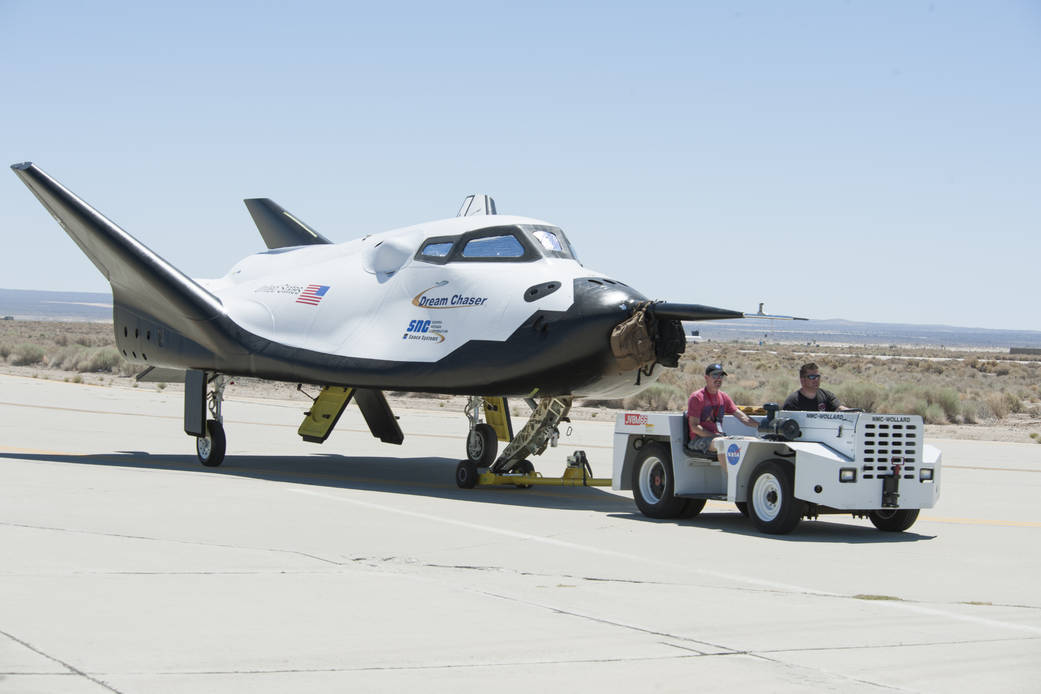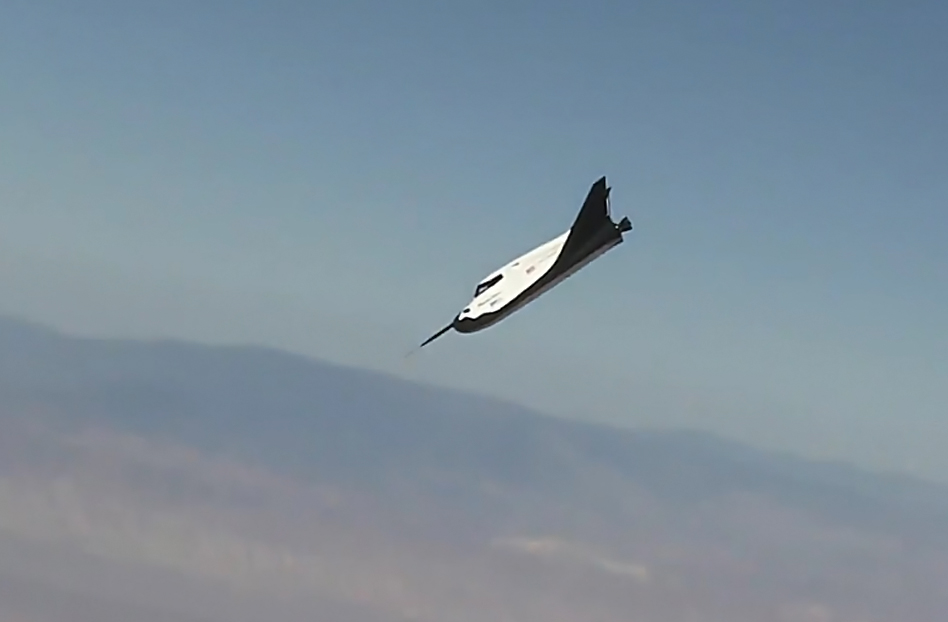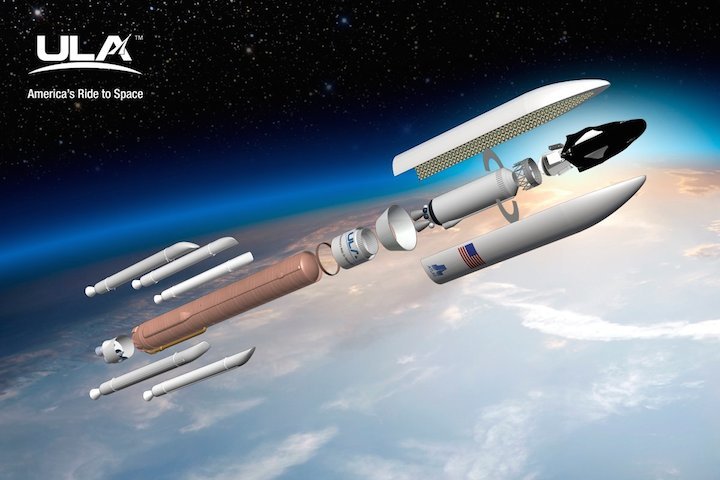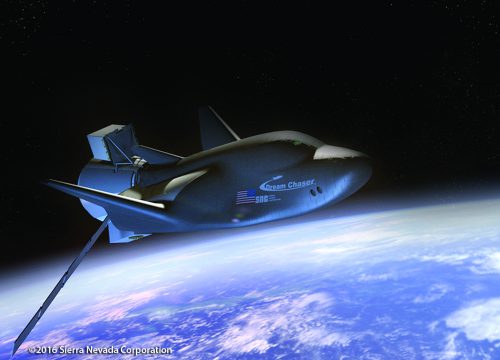
An atmospheric test model of Sierra Nevada’s Dream Chaser space plane is being readied for tow and landing tests at NASA’s Armstrong Flight Research Center in California this spring.
The partially-assembled test craft arrived at the California test site, located on Edwards Air Force Base, on Jan. 25. Technicians are adding the ship’s V-shaped tail fins and other equipment before kicking off ground and flight tests in the coming months, according to Mark Sirangelo, corporate vice president of Sierra Nevada’s space systems division.
“We’ll do a series of ground tests,” Sirangelo said in a recent interview. “That will include towing the vehicle down the runway, and that allows us to see how it stops and how it moves, but it also allows us to test all the sensors on the vehicle because we can get it up to a high enough speed where that will happen.”
The Dream Chaser spacecraft, originally envisioned to fly with astronaut crews, will now fly on space missions with cargo deliveries heading for the International Space Station. That change means the spaceship will return to Earth on autopilot, using navigation aids to descend to a runway, deploy its landing gear and touch down like NASA’s space shuttles.
After the ground tests, Sirangelo said the Dream Chaser test article will perform “captive carry” tests suspended under a helicopter, using the exercises to verify the movements of the craft’s aerosurfaces and navigation instrumentation.
“When that’s done, we’ll move into a series of flight tests, where it will be dropped for approach and landing like the shuttle Enterprise,” Sirangelo said, referring to the vehicle NASA used for landing demonstrations in the 1970s before the first full-up space shuttle mission.
The Dream Chaser will be dropped from heavy-duty carrier helicopter for an autonomous landing at Runway 22L at Edwards Air Force Base.
The test campaign in California’s Mojave Desert comes three-and-a-half years after Sierra Nevada’s Dream Chaser last flew on its own. A drop test in October 2013 ended with a crash landing after the ship’s left landing gear failed to deploy.
Sierra Nevada says the 2013 flight was successful until that point, and Dream Chaser’s autopilot landing system steered the craft toward the runway for a touchdown on the centerline.
Engineers blamed the mishap on a landing gear borrowed from a U.S. Air Force F-5E jet. Future Dream Chaser cargo missions to the space station will fly with a different landing gear, and the spaceship preparing for tests this spring in California features a gear more advanced then the suspect system at fault in 2013.

“We had borrowed that gear for that test, and that was one of the decision we made that didn’t work out, obviously,” Sirangelo said. “It wasn’t the orbital flight design. It’s a completely different design system now, so it’s very different from what we had before. It’s not quite the full orbital design, but it’s on that path.”
After the crash landing in 2013, Sierra Nevada returned the damaged test craft to the company’s facility in Louisville, Colorado, for repairs. While the vehicle set for landing tests in the coming months is the same one that flew in 2013, Sirangelo said it is “substantially upgraded.”
“It’s much more close to the (configuration) of the orbital vehicle now, with flight software,” Sirangelo told Spaceflight Now. “It’s fully autonomous, so it will use flight software that we’ll go to orbit with. All the control surfaces, and all the data gathering is all electronic.
“The computer systems are now the orbital version of the computer systems that we will manage with, so it’s structurally similar, but virtually the whole inside of the vehicle has been updated and changed.”
In 2013, Sierra Nevada was competing with Boeing and SpaceX for lucrative contracts with NASA to carry astronauts to and from the International Space Station. The space agency awarded the crew transportation deals to the other two companies in 2014, leaving Dream Chaser’s future uncertain.
But Sierra Nevada found other business for the lifting body space plane, primarily in the space station’s cargo resupply program. NASA announced in January 2016 that Sierra Nevada, SpaceX and Orbital ATK will be responsible for hauling up most of the space station’s U.S. cargo and experiments from 2019 through 2024, the station’s current planned retirement date.
SpaceX and Orbital ATK are the incumbent commercial cargo transportation contractors, and Sierra Nevada will join them in the follow-on contract.
Sierra Nevada also has agreements with the European Space Agency to study the use of Dream Chaser to provide access to space for European research experiments after the end of the space station program in the 2020s. The United Nations agreed last year to purchase a standalone unpiloted Dream Chaser mission to Earth orbit in 2021 to host research payloads from developing nations.
Sirangelo said the long gap between Dream Chaser flight tests was not only driven by technical concerns — like the upgrade and repair of the test craft — but by closing the business case for the program.
“We had to go and win a contract,” Sirangelo said. “We needed a path to really make this all worthwhile to take this next step. Once we won the contract a year ago, we were able to accelerate the program and get back into flight tests.”
The feeling among Sierra Nevada’s team is different this time, he said.
“Not only are we back in flight tests, but now it’s different in that we know that we have a contract,” Sirangelo said. “We have flights coming up. We’ve got decades of flights in front of us, so it’s a different feeling.”
Under the structure of the cargo resupply contract, each partner must pass several programmatic, safety and integration milestones before flying missions. Sierra Nevada has passed two of those milestones so far, Sirangelo said, and a preliminary design review for the full Dream Chaser system is coming up soon.
NASA has not ordered resupply missions from any of the three providers under the new cargo contract — called Commercial Resupply Services-2 — but Sirangelo said the company hopes to get a firm order and a target launch date from the space agency this year. Each of the three CRS-2 contract winners is guaranteed at least six missions.
On space station resupply runs, the Dream Chaser will take off from Florida on top of United Launch Alliance Atlas 5 rockets and return to runway landings at one of several potential sites, such as the Shuttle Landing Facility at the Kennedy Space Center, for unpacking, refurbishment and reuse.
The Dream Chaser is about one-quarter the size of a space shuttle orbiter, allowing it to land on shorter runways.
It is capable of delivering more than 12,000 pounds (5,500 kilograms) of equipment to the space station inside its pressurized compartment and on an external aft-mounted payload carrier. At the end of each flight, the two parts will detach, with the Dream Chaser space plane returning to Earth with research specimens and other gear, and the disposable cargo module burning up in the atmosphere to incinerate trash.
The fully-loaded spacecraft will weigh around 20 tons and will likely require the lift capacity of ULA’s most powerful Atlas 5 rocket configuration — the “551” with five strap-on solid rocket boosters and a 5-meter (17-foot) payload fairing, according to Sirangelo.
The first space-rated Dream Chaser is “well under design and development” and on schedule, he said.
“We’ve now built the full pressure shell and tested it, and now we’re building the orbital shell — we call it the external structure — the structure of the vehicle, and all the flight software,” Sirangelo said. “A lot of the work has been on the software side because it is a fully autonomous vehicle now, so it’s well on the way to being ready on time.”
Lockheed Martin built the Dream Chaser’s composite structure, and Sierra Nevada will locate the spaceship’s launch site processing facility alongside Lockheed Martin’s Orion production line inside the Neil Armstrong Operations and Checkout Building at the Kennedy Space Center in Florida.
Quelle: SN
---
Update: 26.03.2017
.
Dream Chaser Passes Major CRS-2 Review Milestone, Next Flight Test Nears

Sierra Nevada Corporation engineers and technicians prepare the firm’s Dream Chaser engineering test vehicle for tow tests on a taxiway at NASA’s Armstrong Flight Research Center in Southern California. The vehicle’s second free-flight test is expected later this year. Photo Credit: NASA / Ken Ulbrich
Sierra Nevada Corporation’s Dream Chaser ‘spaceplane’ is another step closer to reality this week, having passed a major milestone review by NASA and the Federal Aviation Administration (FAA) under the space agency’s multi-billion dollar Commercial Resupply Services (CRS-2) program to resupply the International Space Station from 2019-2024.
“Passing the third CRS2 integration milestone is a really big deal for the program and its future,” said Steve Lindsey, vice president of Space Exploration Systems for SNC’s Space Systems business area. “We are proud of this accomplishment and are well on our way towards completing the next critical milestone and the remaining developmental phases. It’s a great feeling to be executing all our milestones on schedule and to be moving forward to our operational flight.”
During the intensive three-day CRS2 Integration Review #3 (IR3), approximately 45 members from NASA and the FAA came together to evaluate all stages of mission operations including ground, launch, flight and landing. Safety and mission assurance criteria, as well as reliability of the vehicle’s design were throughly reviewed too, confirming the Dream Chaser meets NASA’s key requirements to carry out cargo resupply missions under CRS-2 beginning in two years.
NASA contracted SNC to fly at least six missions with their Dream Chaser ‘mini shuttle’ under CRS-2, and the company will put in a bid for a crew version if NASA opens up more multi-billion dollar commercial crew contracts in the future (currently given to Boeing and SpaceX).
No significant design, build or system issues were found that could underscore Dream Chaser’s readiness for flight, according to SNC.
As outlined by the company, major elements of the review included:
- Successful completion of the NASA Phase 1 Safety Review
- 32 Hazard Reports and 16 Safety Data Packages approved by NASA
- Dream Chaser Architectural Design’s met all CRS2 requirements (hardware, software, flight dynamics, thermal control, etc.)
- More than 100 detailed design documents were delivered to NASA along with 30+ design reviews
- During the three-day IR3 review, more than 1,000 charts were briefed, which demonstrated that Dream Chaser is at Preliminary Design Review level of maturity
- Launch vehicle operations, outside subcontracts and agreements
- Range safety plan, as well as FAA, Federal Communications Commission (FCC) and National Telecommunications and Information Administration (NTIA) licensing
- 5 Safety Review Phase 1 meetings were conducted prior to the IR3 review and involved the delivery of 46 individual Safety Data Packages developed under the S&MA team.
This past January, SNC delivered their engineering test prototype to NASA’s Armstrong Flight Research Center in California, located at Edwards Air Force Base, where it has since successfully completed Phase One ground testing in preparation for its next free-flight Approach and Landing Test (ALT-2) on runway 22L.
No date has been given for ALT-2, but SNC expects to conduct it soon.
SNC put their test article through its first free flight Approach and Landing test, ALT-1, at Armstrong three years ago, and the test went about as good as SNC could have hoped for, until the command was given to deploy its landing gear. Only two of its three gear deployed, causing the vehicle to skid off the runway, sustaining minor structural damage.

The Dream Chaser test article in autonomous free flight over NASA’s Armstrong Flight Research Center at Edwards Air Force Base in California Saturday, October 26, 2013. Photo Credit: SNC
The problem was traced to a mechanical issue with the specific landing gear, rather than something related to bad software (none of the primary systems that gave the commands that control the flight failed or had any problems).
SNC has made significant structural and systems improvements to the test article since, including the composite wings and aeroshells, and invested heavily in maturing the vehicle’s orbital avionics, guidance navigation and control, the flight software, and employed a number of new processes, all of which will be used on the orbital vehicle as well. The advanced orbital Thermal Protection System (TPS) was installed on the vehicle’s skid too, in order to do advanced testing of the actual orbital TPS.
Engineers hope to get everything they need out of the upcoming ALT-2 test, but will fly more to validate the aerodynamic properties, flight software, and control system performance of the spacecraft if needed.
The company hopes to launch their first operational Dream Chaser cargo mission to the ISS for NASA in the first half of 2019,
Quelle: AS
+++
DREAM CHASER® SPACECRAFT PASSES MAJOR MILESTONE

SPARKS, Nev., May 25, 2017 – SPARKS, Nev. (May 25, 2017) – Sierra Nevada Corporation (SNC) successfully passed the third integration milestone for the Dream Chaser program under the NASA Commercial Resupply Services (CRS2) program, bringing it a major step closer to providing resupply services to the International Space Station (ISS).
CRS2 Integration Review #3 (IR3) confirmed SNC’s Dream Chaser Cargo System design meets NASA’s key requirements and maximizes probability of mission success during future flights. The spacecraft is scheduled for at least six missions between 2019 and 2024. The reliability of the Dream Chaser design was also thoroughly reviewed as part of NASA’s Phase I Safety Review Process, which successfully demonstrated safety and mission assurance criteria. The reviews covered all stages of mission operations including ground, launch, flight and landing.
“Passing the third CRS2 integration milestone is a really big deal for the program and its future,” said Steve Lindsey, vice president of Space Exploration Systems for SNC’s Space Systems business area. “We are proud of this accomplishment and are well on our way towards completing the next critical milestone and the remaining developmental phases. It’s a great feeling to be executing all our milestones on schedule and to be moving forward to our operational flight.”
The spacecraft’s unique cargo design transports more cargo mass (5,500 kilograms) to the ISS each mission. In addition, a significant amount of cargo, almost 2,000 kilograms is directly returned from the ISS to a gentle runway landing at a pinpoint location. Dream Chaser’s all non-toxic systems design allows personnel to simply walk up to the vehicle after landing, providing immediate access to time-critical science as soon as the wheels stop.
The complex and thorough review process found no significant design, build or system issues and underscored the Dream Chaser’s readiness for flight.
The major elements of Milestone 3 included:
- Successful completion of the NASA Phase 1 Safety Review
- 32 Hazard Reports and 16 Safety Data Packages approved by NASA
- Dream Chaser Architectural Design’s met all CRS2 requirements (hardware, software, flight dynamics, thermal control, etc.)
- More than 100 detailed design documents were delivered to NASA along with 30+ design reviews
- During the three-day IR3 review, more than 1,000 charts were briefed to the approximate 45 member NASA and Federal Aviation Administration (FAA) team, which demonstrated that Dream Chaser is at Preliminary Design Review level of maturity
- Launch vehicle operations, outside subcontracts and agreements
- Range safety plan, as well as FAA, Federal Communications Commission (FCC) and National Telecommunications and Information Administration (NTIA) licensing
- 5 Safety Review Phase 1 meetings were conducted prior to the IR3 review and involved the delivery of 46 individual Safety Data Packages developed under our S&MA team.
In addition to completing this milestone, the Dream Chaser atmospheric test vehicle is in preparations for flight testing that will help verify these designs. The spacecraft is currently testing at NASA’s Armstrong Flight Research Center in California, having just successfully completed Phase One ground testing leading up to its second free flight test later this year.
About Dream Chaser Spacecraft
Owned and operated by SNC, the Dream Chaser spacecraft is a reusable, multi-mission space utility vehicle (SUV). It is capable of transportation services to and from low-Earth orbit, where the International Space Station (ISS) resides, and is the only commercial, lifting-body vehicle capable of a runway landing. The Dream Chaser Cargo System was selected by NASA to provide cargo delivery and disposal services to the ISS under the Commercial Resupply Services 2 (CRS2) contract. All Dream Chaser CRS2 cargo missions are planned to land at Kennedy Space Center’s Shuttle Landing Facility.
About Sierra Nevada Corporation
Recognized as one of “The World’s Top 10 Most Innovative Companies in Space,” Sierra Nevada Corporation (SNC) provides customer-focused advanced technology solutions in the areas of space, aviation, electronics and systems integration. SNC’s Space Systems business area based in Louisville, Colorado, designs and manufactures advanced spacecraft, space vehicles, rocket motors and spacecraft subsystems and components for the U.S. Government, commercial customers, as well as for the international market. SNC has more than 25 years of space heritage, participating in more than 450 successful space missions and delivering 4,000+ systems, subsystems and components around the world.
For more information on SNC visit www.sncorp.com and follow us at Facebook.com/SierraNevCorp and Twitter @SierraNevCorp. Sierra Nevada Corporation and SNC are trademarks of Sierra Nevada Corporation.
Quelle: SNC
---
Update: 20.07.2017
.
United Launch Alliance Signs Contract with Sierra Nevada Corporation to Launch Dream Chaser® Spacecraft to Deliver Cargo to International Space Station
“ULA is pleased to partner with Sierra Nevada Corporation to launch its Dream Chaser cargo system to the International Space Station in less than three years,” said Gary Wentz, ULA vice president of Human and Commercial Systems. “We recognize the importance of on time and reliable transportation of crew and cargo to Station and are honored the Atlas V was selected to continue to launch cargo resupply missions for NASA.”
The two awarded Atlas V missions will carry pressurized and unpressurized cargo to the International Space Station (ISS). The first mission is set to lift off in 2020 from Space Launch Complex 41 at Cape Canaveral Air Force Station, in Florida. The second contracted mission is scheduled to lift off in 2021. Dream Chaser will launch atop an Atlas V 552, with a dual engine Centaur upper stage.
“SNC recognizes the proven reliability of the Atlas V rocket and its availability and schedule performance makes it the right choice for the first two flights of the Dream Chaser,” said Mark Sirangelo, corporate vice president of SNC's Space Systems business area. “ULA is an important player in the market and we appreciate their history and continued contributions to space flights and are pleased to support the aerospace community in Colorado and Alabama,” added Sirangelo.
The Atlas V has received NASA’s highest and most rigorous Category 3 Certification, which allows the Atlas V family of launch vehicles to fly NASA’s most complex and critical missions.
The Dream Chaser spacecraft has been in development for more than 10 years, including six years as part of NASA’s Commercial Crew Program and leverages more than 40 years of NASA spaceflight and space shuttle heritage. In 2016, Dream Chaser was selected by NASA under the CRS2 contract to transport pressurized and unpressurized cargo to and from the ISS with return and disposal services.
About United Launch Alliance
With more than a century of combined heritage, United Launch Alliance is the nation’s most experienced and reliable launch service provider. ULA has successfully delivered more than 115 satellites to orbit that aid meteorologists in tracking severe weather, unlock the mysteries of our solar system, provide critical capabilities for troops in the field and enable personal device-based GPS navigation.
SIERRA NEVADA CORPORATION SELECTS UNITED LAUNCH ALLIANCE ATLAS V FOR FIRST TWO DREAM CHASER® SPACECRAFT MISSIONS
SPARKS, Nev., July 19, 2017 – Sierra Nevada Corporation (SNC) selected United Launch Alliance (ULA) and the Atlas V rocket for the first two missions of its Dream Chaser spacecraft. The Dream Chaser is scheduled to go to the International Space Station around 2020 for cargo resupply services as part of NASA’s CRS2 contract.
“SNC recognizes the proven reliability of the Atlas V rocket and its availability and schedule performance makes it the right choice for the first two flights of the Dream Chaser,” said Mark Sirangelo, corporate vice president of SNC's Space Systems business area. “ULA is an important player in the market and we appreciate their history and continued contributions to space flights and are pleased to support the aerospace community in Colorado and Alabama,” added Sirangelo.

Photo Credit: ULA
About Sierra Nevada Corporation
Recognized as one of "The World's Top 10 Most Innovative Companies in Space," Sierra Nevada Corporation (SNC) provides customer-focused advanced technology solutions in the areas of space, aviation, electronics and systems integration. SNC's diverse technologies are used in applications including space exploration and satellites, aircraft integrations, navigation and guidance systems, threat detection and security, scientific research and infrastructure protection. Founded in 1963 and headquartered in Sparks, Nevada, SNC operates under the leadership of owners, CEO Fatih Ozmen and President Eren Ozmen, with a workforce of more than 3,000 personnel in 34 locations in 19 U.S. states, England, Germany and Turkey providing global support to customers.
Quelle: SNC

